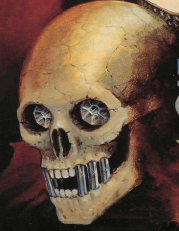 |
| Hey there, neighbor |
Tomb of Horrors: Tomb of Acererak Level
33. Crypt of Acererak the Eternal
We're finally in the Tomb itself, the last area, the big one.
 |
| Pictured: your prize. Happy now? |
That theme continues through the area. This is Gary's final test of the skills learned throughout the dungeon. Before we go into the details of this area, let's review the lessons learned in the Tomb of Horrors.
- Inspect Everything (using detect evil and detect magic, as much as possible)
- The Tomb is deadly but fair
- Brute force doesn't solve problems
- NPCs are usually friendly
Inspect Everything
Things to inspect, especially with detect magic, identify, or detect evil:
- Cursed Swords and Spears
- The dust of the demilich
- The skull of the demilich
The Tomb is Deadly but Fair
 |
| Insane, but logically so |
Brute Force doesn't Solve Problems
This could be the subtitle to this area. Both the ghost and the skull are only activated by tampering with them. There are three cursed weapons, and one is specifically a Spear of Backbiting, which hurts the wielder when they roll a natural 1.
Gary is really trying to clue the players in: Don't Fight!
NPCs are Usually Friendly
This is a tricky one, but the dust does form a man-like shape. This could lead to some parties questioning it rather than attacking.
It also leads to a novel solution to the skull problem: if the players befriended the siren, she can use her touch to cause the idiocy of the area she was found in. This effect lasts for 5d4 turns, but that would be long enough for Acererak to float back down without stealing a soul.
So what are we to take away from this area? If anything its that the final area of a dungeon should have the theming of the dungeon, but it should also culminate the various lessons taught throughout the campaign.
Tomb of Horrors: Final Thoughts
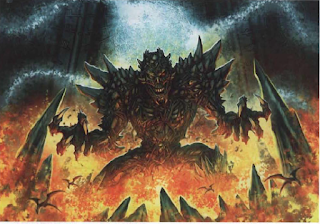 |
| Sometimes that lesson is: devour the souls of mortals |
So, we've laid out the lessons of the Tomb of Horrors, tested them thoroughly in the final areas, and seen a breakdown of the entire dungeon. The question then becomes: were the lessons valuable?
Let's break it down on three different levels.
To a modern RPG player, I would say that they are not that helpful. Inspecting everything in a story-driven game bogs down play and creates a sense of distrust between player and DM. Making a game deadly means that the characters in the story might not make it through the story. Although you could argue that not using brute force and trusting NPCs are good lessons, there are better ways to teach them. Additionally, story-driven games sometimes result in unavoidable violence, and sometimes NPCs are to be inspected, instead of trusted.
To a Dungeon Master, I believe the lessons taught by Tomb of Horrors are extremely valuable. They aren't the same lessons a player would learn, but a DM can learn theming, encounter and trap building, different ways to challenge players, and how to foreshadow traps and plot from this module. In this regard, I think Dungeon Masters should read and understand the Tomb of Horrors, even if they also acknowledge that their players would probably not benefit from being put through its rigours.
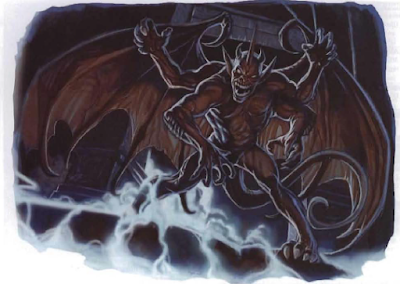 |
| Lesson: was anybody really scared of the gargoyles? Did we need them everywhere? |
- Inspect everything is a good lesson. Knowing more about the world around you is a good skill and preferable to ignorance.
- Life can be brutal, but there is a logical consistency to it, much like the Tomb. Learning the principles by which life operates can lead to a better understanding and a more powerful experience.
- Violence is never the answer, even in the face of other people being violent.
- People can be spoken to and reasoned with, empathized with and loved, no matter who they are or appear to be.
Tomb of Horrors: Related Products
I did want to address some products related to the Tomb of Horrors and how they fit with the module. I'll give a brief synopsis, then my opinion on their level of quality.
Return to the Tomb of Horrors
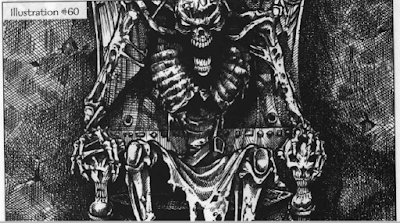 |
| Come, sit in my lap, tell me what your heart desires... |
I enjoyed the story leading up to the Tomb, but the latter half left a bad taste in my mouth. It was obviously designed to be deadlier than the tomb itself and left me wondering how any party could wend their way through the instant-death effects of The City that Waits and Acererak's Fortress of Conclusion. The module doesn't uphold the lessons or tone of the original dungeon, needing the player's knowledge of the original Tomb to hold their interest.
Again, I would look into the first part of this adventure. Skull City is a cool concept, and leading the players up to the Tomb is a good way to build up the campaign. But don't expect your players to make it to the end, or like the adventure afterwards.
Tomb of Horrors (4e)
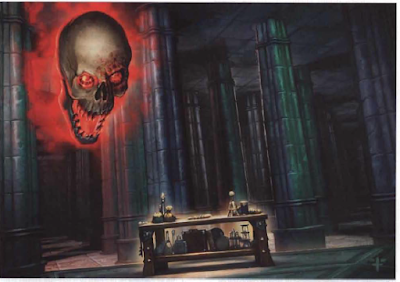 |
| Sometimes you just need a few days of alone time... |
Of the non-direct-conversion adventures, I highly prefer this one. It does absolutely require the players to be aware of the Tomb of Horrors, and it's helpful if at they have a little knowledge of Return as well. However, the adventure seeks not to recreate the deadliness of the original module, but instead make the tone of fighting a powerful lich with epic ambitions apparent, while adapting the modules to a modern gamer's level.
I don't think this module preserves the lessons of the Tomb of Horrors, but instead revises them into a more story-focused adventure suitable for modern players. They don't try to make another death-trap, they try to convey the story of the Tomb of Horrors and how it got to where it was. They even include clue poems! My heart!
There are a lot of good ideas to pull from this adventure, but I can't say it could be ran as a standalone module. There's simply too many nods and hints towards the previous adventures.
Tales from the Yawning Portal
This collection of adventures includes a 5th-edition conversion of the original Tomb of Horrors. I've left the conversions off of this list up until now, but since this one was just released, I wanted to address it.
 |
| Look at me! I'm popular! |
This is a near letter-perfect reproduction of the Tomb, even including some of Gary's original wording in the room descriptions. The puzzles and riddles are preserved exactly, and all of the instant death traps are still just as deadly.
However, the thing that I'm most impressed with is that they preserved the slow learning process of the Tomb. With Tomb of Horrors, it's easy to make everything horrible and deadly, but the early traps in this version are mid-range damage, meaning a party may well make it into the deeper parts of the Tomb. As I've mentioned in previous articles, this dungeon is about teaching and experimenting, and they try to preserve that.
I'm also very happy with how Gary's "Count down from 10" instructions were updated for the initiative-based combat of modern D&D. Now, these traps trigger on initiative counts (10 is common) making initiative important in a combat-light dungeon. Awesome.
My final (and only negative) note on the conversion is that Acererak is a full-blown Demilich (MM pg. 48) rather than being the soul-sucking trap from the original. This takes away from the lesson that brute force won't solve problems. Also, the blessed sword in the final room is a Defender. They finally made a high-level campaign and couldn't give out a Vorpal Sword or Holy Avenger?
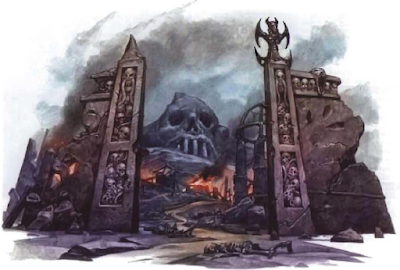 |
| So long, farewell... and good riddance! |
Please let me know if you enjoyed this type of article. There are a lot of classic modules out there, from the recently-reprinted White Plume Mountain to rarely-revisited adventures like The Sinister Secret of the Saltmarsh. Being a D&D player for only a few years myself, it was a lot of fun to dig through this old tome, and I would definitely be interested in doing so again if there was some interest.
Thanks for reading!

These articles have been a good read, thank you!
ReplyDeleteI've been interested in running the Tomb of Horrors, but hadn't taken the time to read through the module yet (though I've been working on the map). You have a lot of interesting insights, and I like how you focused on an older version so I could read along in 5e's version to compare and contrast. A few things felt left out between some rooms, and maybe a couple were drastically altered, but I got the gist of it and feel a lot more prepared for when I get some players together for it.